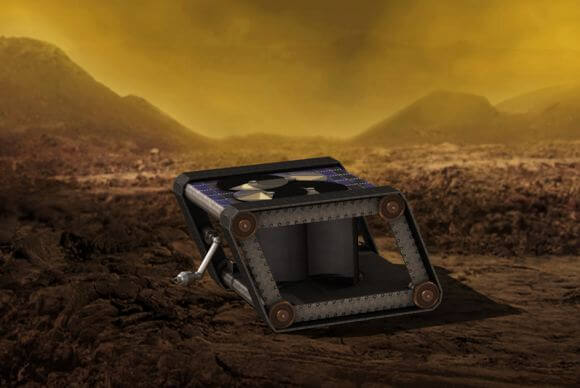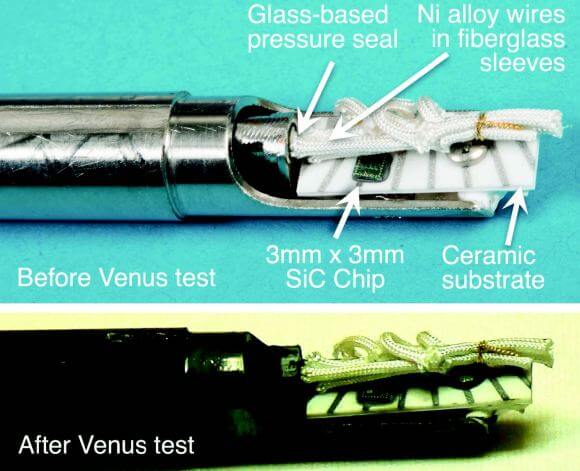
Weather on Venus — of Dante’s Inferno. The average surface temperature is 462 degrees — high enough to melt lead and atmospheric pressure 92 times higher than on Earth at sea level (9,2 MPa). For these reasons, few automatic mission could get on the surface of Venus, and those that could, did not last long — from 20 minutes to 2 hours, not more.
That’s why NASA is planning future missions, tends to produce robots and components that can survive in the atmosphere of Venus for extended periods of time. These include new generation electronics, which was recently presented by scientists from the Research center at NASA Glenn (GRC). The electronics will allow the lander to explore the surface of Venus for several weeks, months or even years.
In the past the landers developed by the USSR and NASA to study Venus — programmes Venera and Mariner respectively — relied on standard electronics, which was lying silicon semiconductors. They are simply not capable to work in conditions of temperature and pressure that occur on the surface of Venus, and therefore require containment and cooling systems.
Of course, it was just a matter of time when the protection system fails and the probe will stop transmitting data. The record failed to establish the Soviet Union with the probe “Venera-13” which transmit data over 127 minutes of descent and landing. Looking ahead, NASA and other space agencies want to develop the probes that will be able to collect as much information as possible about the atmosphere, surface, and geological history of Venus before we die.
To do this, the team from the GRC is working on electronics that will rely on semiconductors made of silicon carbide (SiC), which can work at temperature of Venus or above. Recently the team conducted a demonstration using the world’s first chip of average complexity based on SiC, which consisted of a dozen or more transistors in the core digital logic and analog amplifiers.

These schemes, which will be used in all electronic systems of future missions, were able to operate up to 4,000 hours at a temperature of 500 degrees — effectively demonstrated that may exist in the Venusian conditions for a long time. These tests were carried out in the GEER environment that simulates conditions on the surface of Venus, including extreme temperature and high pressure.
In April 2016 GRC team tested a ring oscillator 12 semiconductors for 521 hours (21.7 per day). During the tests, they raised the temperature of the circuits to 460 degrees, atmospheric pressure to 9.3 MPa and the level of CO2 and other trace gases to supercritical. Throughout this process, the oscillator based on SiC have demonstrated good stability and continued to work.
The trial ended after 21 days due to schedule but was able to continue. However, this result has provided a world record, far surpassing the achievements of any other missions. Similar tests showed that the ring oscillator can survive thousands of hours at a temperature of 500 degrees on earth.
Such electronics represents an important paradigm shift in space exploration and can afford to be missions that were previously impossible. NASA plans to include electronics based on SiC in the probe LLISSE. Its prototype is currently being developed for the extraction of basic but very valuable scientific measurements of Venus ‘ surface.

Other plans to create a tenacious researcher of Venus include AREE, “steampunk Rover”, which relies on analog components, rather than complex electronic systems. While these concepts are intended to fully redeem us from electronics to mission on Venus could continue indefinitely, and new electronics based on SiC will allow more complex Rovers to work in extreme conditions.
Yes and no Venus, these technologies can lead to the emergence of a new class of probes, able to explore the depths of the gas giants — Jupiter, Saturn, Uranus and Neptune — whose temperature and pressure were too inaccessible in the past. The probe, with durable hardened shell and electronic circuits based on SiC, could penetrate deep into the bowels of the planet and to get new information about their atmospheres and magnetic fields.
The surface of mercury would also be available for Rovers and landing modules, using the new technology, even in the daytime, when the temperature rises to 427 degrees. Even on Earth there are many extreme places that could be explored with SiC circuits.
Maybe one day we will be able to explore even the bowels of the star?
Electronics that can operate on Venus: how to create it?
Ilya Hel